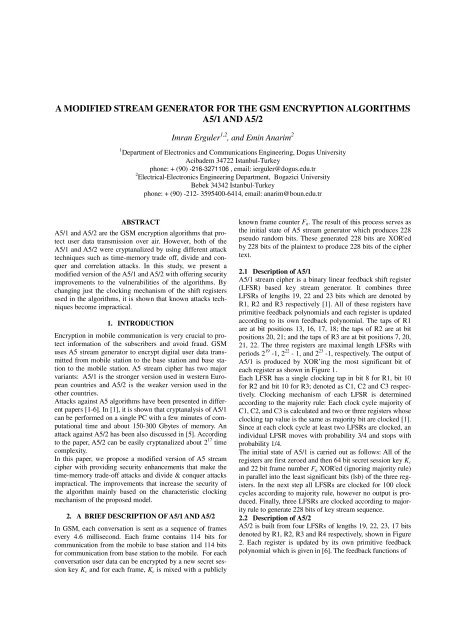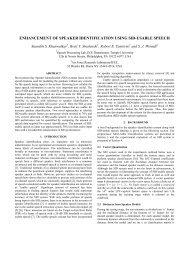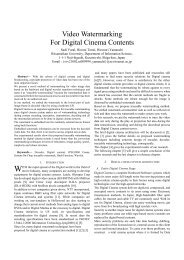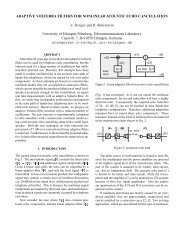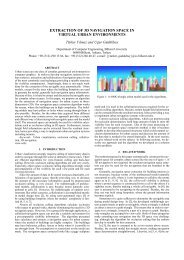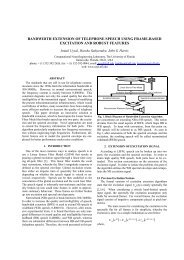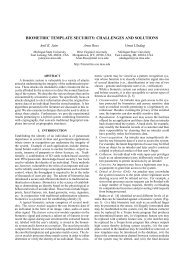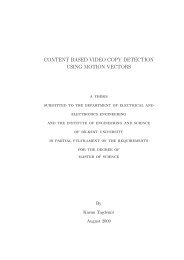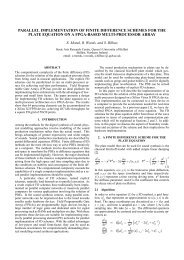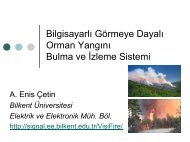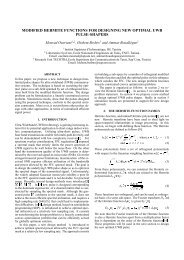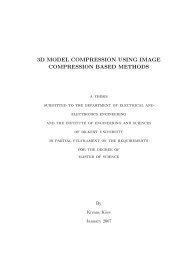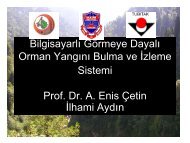a modified stream generator for the gsm encryption ... - CiteSeerX
a modified stream generator for the gsm encryption ... - CiteSeerX
a modified stream generator for the gsm encryption ... - CiteSeerX
Create successful ePaper yourself
Turn your PDF publications into a flip-book with our unique Google optimized e-Paper software.
A MODIFIED STREAM GENERATOR FOR THE GSM ENCRYPTION ALGORITHMSA5/1 AND A5/2Imran Erguler 1,2 , and Emin Anarim 21 Department of Electronics and Communications Engineering, Dogus UniversityAcibadem 34722 Istanbul-Turkeyphone: + (90) -216-3271106 , email: ierguler@dogus.edu.tr2 Electrical-Electronics Engineering Department, Bogazici UniversityBebek 34342 Istanbul-Turkeyphone: + (90) -212- 3595400-6414, email: anarim@boun.edu.trABSTRACTA5/1 and A5/2 are <strong>the</strong> GSM <strong>encryption</strong> algorithms that protectuser data transmission over air. However, both of <strong>the</strong>A5/1 and A5/2 were cryptanalized by using different attacktechniques such as time-memory trade off, divide and conquerand correlation attacks. In this study, we present a<strong>modified</strong> version of <strong>the</strong> A5/1 and A5/2 with offering securityimprovements to <strong>the</strong> vulnerabilities of <strong>the</strong> algorithms. Bychanging just <strong>the</strong> clocking mechanism of <strong>the</strong> shift registersused in <strong>the</strong> algorithms, it is shown that known attacks techniquesbecome impractical.1. INTRODUCTIONEncryption in mobile communication is very crucial to protectin<strong>for</strong>mation of <strong>the</strong> subscribers and avoid fraud. GSMuses A5 <strong>stream</strong> <strong>generator</strong> to encrypt digital user data transmittedfrom mobile station to <strong>the</strong> base station and base stationto <strong>the</strong> mobile station. A5 <strong>stream</strong> cipher has two majorvariants: A5/1 is <strong>the</strong> stronger version used in western Europeancountries and A5/2 is <strong>the</strong> weaker version used in <strong>the</strong>o<strong>the</strong>r countries.Attacks against A5 algorithms have been presented in differentpapers [1-6]. In [1], it is shown that cryptanalysis of A5/1can be per<strong>for</strong>med on a single PC with a few minutes of computationaltime and about 150-300 Gbytes of memory. Anattack against A5/2 has been also discussed in [5]. Accordingto <strong>the</strong> paper, A5/2 can be easily cryptanalized about 2 17 timecomplexity.In this paper, we propose a <strong>modified</strong> version of A5 <strong>stream</strong>cipher with providing security enhancements that make <strong>the</strong>time-memory trade-off attacks and divide & conquer attacksimpractical. The improvements that increase <strong>the</strong> security of<strong>the</strong> algorithm mainly based on <strong>the</strong> characteristic clockingmechanism of <strong>the</strong> proposed model.2. A BRIEF DESCRIPTION OF A5/1 AND A5/2In GSM, each conversation is sent as a sequence of framesevery 4.6 millisecond. Each frame contains 114 bits <strong>for</strong>communication from <strong>the</strong> mobile to base station and 114 bits<strong>for</strong> communication from base station to <strong>the</strong> mobile. For eachconversation user data can be encrypted by a new secret sessionkey K c and <strong>for</strong> each frame, K c is mixed with a publiclyknown frame counter F n . The result of this process serves as<strong>the</strong> initial state of A5 <strong>stream</strong> <strong>generator</strong> which produces 228pseudo random bits. These generated 228 bits are XOR'edby 228 bits of <strong>the</strong> plaintext to produce 228 bits of <strong>the</strong> ciphertext.2.1 Description of A5/1A5/1 <strong>stream</strong> cipher is a binary linear feedback shift register(LFSR) based key <strong>stream</strong> <strong>generator</strong>. It combines threeLFSRs of lengths 19, 22 and 23 bits which are denoted byR1, R2 and R3 respectively [1]. All of <strong>the</strong>se registers haveprimitive feedback polynomials and each register is updatedaccording to its own feedback polynomial. The taps of R1are at bit positions 13, 16, 17, 18; <strong>the</strong> taps of R2 are at bitpositions 20, 21; and <strong>the</strong> taps of R3 are at bit positions 7, 20,21, 22. The three registers are maximal length LFSRs withperiods 2 19 -1, 2 22 - 1, and 2 23 -1, respectively. The output ofA5/1 is produced by XOR’ing <strong>the</strong> most significant bit ofeach register as shown in Figure 1.Each LFSR has a single clocking tap in bit 8 <strong>for</strong> R1, bit 10<strong>for</strong> R2 and bit 10 <strong>for</strong> R3; denoted as C1, C2 and C3 respectively.Clocking mechanism of each LFSR is determinedaccording to <strong>the</strong> majority rule: Each clock cycle majority ofC1, C2, and C3 is calculated and two or three registers whoseclocking tap value is <strong>the</strong> same as majority bit are clocked [1].Since at each clock cycle at least two LFSRs are clocked, anindividual LFSR moves with probability 3/4 and stops withprobability 1/4.The initial state of A5/1 is carried out as follows: All of <strong>the</strong>registers are first zeroed and <strong>the</strong>n 64 bit secret session key K cand 22 bit frame number F n XOR'ed (ignoring majority rule)in parallel into <strong>the</strong> least significant bits (lsb) of <strong>the</strong> three registers.In <strong>the</strong> next step all LFSRs are clocked <strong>for</strong> 100 clockcycles according to majority rule, however no output is produced.Finally, three LFSRs are clocked according to majorityrule to generate 228 bits of key <strong>stream</strong> sequence.2.2 Description of A5/2A5/2 is built from four LFSRs of lengths 19, 22, 23, 17 bitsdenoted by R1, R2, R3 and R4 respectively, shown in Figure2. Each register is updated by its own primitive feedbackpolynomial which is given in [6]. The feedback functions of
Figure 1 - The A5/1 Stream CipherR1, R2 and R3 of A5/2 are <strong>the</strong> same as those of R1, R2 andR3 of A5/1. Clocking of R1, R2 and R3 is controlled by R4and R4 is regularly clocked in each clock cycle. Majority of<strong>the</strong> bits, R4(3), R4(7) and R4(10), is calculated and a binaryresult according to majority rule is obtained. If <strong>the</strong> result is<strong>the</strong> same as R4(3), <strong>the</strong>n R2 is clocked, if <strong>the</strong> result is <strong>the</strong>same as R4(7), <strong>the</strong>n R3 is clocked and if <strong>the</strong> result is <strong>the</strong>same as R4(10) <strong>the</strong>n R1 is clocked. After <strong>the</strong> clocking of R1,R2 and R3, R4 are clocked. It is obvious that, <strong>the</strong> clock controlmechanism of both A5/1 and A5/2 depends on majorityrule. However inputs to clocking control mechanism aregiven from R4 in case of A5/2, while in A5/1 inputs are fromR1, R2 and R3. The output bit is generated as follows: ineach register majority of two bits and complementary of athird bit is calculated; <strong>the</strong> results of all <strong>the</strong> majorities and <strong>the</strong>right most bit from each register are XOR’ed to <strong>for</strong>m <strong>the</strong>output bit.Most of attacks against A5/1 and A5/2 make use of <strong>the</strong> securityflaws in clocking mechanisms of <strong>the</strong> algorithms. ForA5/2, R4 controls clocking of <strong>the</strong> o<strong>the</strong>r LFSRs. So if <strong>the</strong>initial state of R4 is determined, <strong>for</strong> each known output bit,exact number of times that a register is clocked to generate<strong>the</strong> output bit can be known. As a result with <strong>the</strong> knowledgeof feedback polynomial of <strong>the</strong> four LFSR’s, every bit of <strong>the</strong>output can be expressed as a quadratic multivariate functionin <strong>the</strong> initial state and <strong>the</strong> attack presented in [6] can be applied.There are also attacks on A5/1 due to its poor clockingmechanism, although it is <strong>the</strong> strong version. In [2] and [3]divide & conquer attacks have been applied. According to<strong>the</strong>se studies: Since <strong>the</strong> clocking tap positions of R1, R2 andR3 are known, linear equations about <strong>the</strong> LFSRs content canbe obtained by guessing <strong>the</strong> some bits be<strong>for</strong>e <strong>the</strong> clocking tapbits. It is shown that by using <strong>the</strong>se linear equations A5/1 canbe cryptanalized.To overcome <strong>the</strong> above problems, we offer a new clockingmechanism <strong>for</strong> A5 <strong>stream</strong> <strong>generator</strong>. The proposed <strong>generator</strong>consists of four LFSRs denoted as R1, R2, R3 and R4 respectively,depicted in Figure 3. These registers are chosen<strong>the</strong> same as those of A5/2 to avoid hardware efficiency loss.The new <strong>stream</strong> <strong>generator</strong> works as follows:For each clock cycle output of R4, R4(16), is checked; if it is1 <strong>the</strong>n majority of clocking taps R1(14), R2(9) and R3(3)denoted as C1,C2 and C3 respectively is calculated. The registerswhose clocking tap value agrees with <strong>the</strong> majority resultare clocked. However if <strong>the</strong> R4(16) is 0 <strong>the</strong>n majorityresult is not applied, instead <strong>the</strong> following match rule is used.In <strong>the</strong> match rule three function values, F1, F2 and F3 thatare related to R1, R2 and R3 respectively are computed asshown below.F1 = R1(3)⊕ R3(7)⊕ R4(8)F 2 = R2(16)⊕ R1(6)⊕ R4(12)F 3 = R3(11)⊕ R2(13)⊕ R4(3)If F1 is 1, <strong>the</strong>n R1 is clocked, if F2 is 1 <strong>the</strong>n R2 is clockedand if F3 is 1, <strong>the</strong>n R3 is clocked. The register, whose relatedfunction value is 0, is not clocked. However, if all of F1, F2and F3 are 0, all of <strong>the</strong> three registers are clocked to avoidstopping of R1, R2 and R3 at <strong>the</strong> same time.Figure 2 - The A5/2 Stream Cipher3. THE PROPOSED STREAM CIPHER MODELFigure 3 - The Proposed Stream CipherAfter <strong>the</strong> clocking of R1, R2 and R3 is done (according tomajority rule or match rule), R4 is clocked once. The outputof <strong>the</strong> <strong>generator</strong> is generated by XOR’ing <strong>the</strong> most significantbits of R1, R2 and R3, as in <strong>the</strong> case of A5/1.The whole clocking mechanism is summarized in Table 1.As it is mentioned be<strong>for</strong>e, inputs to clocking control mechanismare given from only R4 in case of A5/2, and in A5/1inputs are from R1, R2 and R3. On <strong>the</strong> o<strong>the</strong>r hand, <strong>for</strong> <strong>the</strong>new clocking model all of <strong>the</strong> four LFSRs give input to <strong>the</strong>
clocking mechanism which provides security enhancementsagainst to divide and conquer attacks.Table 1 - Clocking of R1, R2 and R34. SECURITY OF THE STREAM GENERATORIn cipher design, <strong>the</strong> essential point that a designer has toconsider is resistance of <strong>the</strong> cipher against different attacks.There<strong>for</strong>e, in this section we investigate some known attacksapplied on A5 with respect to <strong>the</strong> proposed <strong>stream</strong> <strong>generator</strong>to show its security enhancements.4.1 Time memory trade-off attacksIn Eurocrypt 1997, Golic presented a time-memory trade-offattack against A5/1, based on birthday paradox yielding <strong>the</strong>unknown internal state at a known time <strong>for</strong> a known key<strong>stream</strong> sequence [2]. In fact <strong>the</strong> main principle of this attackis <strong>the</strong> same as time-memory tradeoff of S. Babbage’s idea[7]. There<strong>for</strong>e it is usually known as BG time memory tradeoffattack. If N represents total number of solution space <strong>for</strong>LFSR’s internal state, M represents amount of requiredmemory and T represents required computational time of <strong>the</strong>attack, it has been shown that solution space N can be distributedbetween time T and memory M, where <strong>the</strong> inequalityTM ≥ N must be hold <strong>for</strong> <strong>the</strong> success of <strong>the</strong> attack. Sincetotal length of A5/1 <strong>stream</strong> cipher is 64-bit, <strong>the</strong>re are 2 64 differentpossibilities <strong>for</strong> <strong>the</strong> internal states of three LFSRs.However <strong>the</strong>re are 3/8 unreachable states from internal states,so this number reduces to about 2 63.32 as total solution spaceN according to [2]. For a given 2 21 known different key<strong>stream</strong> sequences corresponding to 2 21 different frames, <strong>the</strong>necessary memory and computational time are obtained as35.65M ≈ 2 and27.67T ≈ 2 respectively [2].In <strong>the</strong> proposed <strong>stream</strong> <strong>generator</strong>, <strong>the</strong>re are four LFSR’s oftotal length 81, so according to this model N becomes as 2 81 .Considering <strong>the</strong> new algorithm, <strong>the</strong> memory and time requirementsaccording to <strong>the</strong> approach in [2], one can showthat, cryptanalysis of <strong>the</strong> proposed model needs 2 17 =131072times more memory or 2 17 times more time. Both of <strong>the</strong> casesseem infeasible, because as <strong>the</strong> memory increases from 2 35.65to 2 52.65 , it becomes about 130153 terabyte. Also according tothis attack, computational time can not exceed 2 28.67 , since atmost 2 22 different frames can be used with <strong>the</strong> same K c .There<strong>for</strong>e required increase in computational time is alsoimpossible with this idea. So Golic’s attack is impracticalwith regarding <strong>the</strong> new <strong>stream</strong> <strong>generator</strong>.A. Biryukov et al. have presented an improved time-memorytrade-off attacks as biased birthday attack [1]. This attackmakes an improvement to Golic’s time-memory trade-off bydefining a specific pattern which is generated by preprocessingmany samples. Then in <strong>the</strong> case of occurrence of thispattern in output key <strong>stream</strong> sequence, possible internal statesare found. According to [1], if R represents number of specialstates (red states) that are kept on disk, t represents availableknown conversation as number of known key <strong>stream</strong> correspondingto different frames, k represents length of specificpattern and W(s) represents weight of a special state s, <strong>the</strong>n<strong>the</strong> expected number of colliding special states in <strong>the</strong> diskand <strong>the</strong> actual data is expressed as:RW ( s)t(1)N2where N is total number of solution space <strong>for</strong> LFSR’s internalstate. In [2], <strong>the</strong> results have been given <strong>for</strong> R=2 35 ,W(s)=12500, t = 120*1000/4.6= 26087 about 2 minutes ofknown conversation and N=2 64 due to total length of A5/1.For <strong>the</strong>se values (1) becomes 0.61 which makes it quitelikely that a collision will actually exist. The requirements of<strong>the</strong> attack are 146 gigabytes as memory and two minutes aslength of known conversation.This attack can be considered <strong>for</strong> <strong>the</strong> proposed <strong>generator</strong>.However as can be seen, (1) becomes 2 17 times smaller dueto large value of N=2 81 <strong>for</strong> <strong>the</strong> new model. To solve thisproblem, <strong>the</strong> attacker has to increase multiplication of numberof special states kept on disk and <strong>the</strong> length of <strong>the</strong> conversation2 17 times more. If <strong>the</strong> attacker makes a trade offbetween time and memory and he can change <strong>the</strong> requirementsas 18.25 terabytes <strong>for</strong> memory and 1.4 days <strong>for</strong> knownconversation length. Nei<strong>the</strong>r requirement seems to be sensible,so we can say that this attack is also impractical withregarding <strong>the</strong> new model.4.2 Divide-and-conquer attacksDivide-and-conquer attacks work by guessing a part of <strong>the</strong>secret internal state of <strong>the</strong> <strong>stream</strong> cipher and <strong>the</strong>n deducing<strong>the</strong> unknown part of <strong>the</strong> state. So it is something like; guesssome bits determine <strong>the</strong> o<strong>the</strong>rs. Golic has described a divideand conquer attack on A5/1 <strong>stream</strong> cipher in [2]. The mainidea of <strong>the</strong> attack is getting 63.32 linear equations and <strong>the</strong>nobtaining internal state of LFSR’s by solving <strong>the</strong>se equations.According to this attack, firstly n bits from each register isguessed and from <strong>the</strong>se bits, attacker infer 3n linear equations,where n can not be bigger than <strong>the</strong> shortest distancebetween clocking tap bit and output bit of LFSR. From this,<strong>the</strong> attacker obtains about 4n/3 linear equations, since assumedbits on average define 4n/3 elements of clock controlsequence and output is known [2]. Also known first outputbit gives extra one linear equation, so totally attacker canhave 3n+ 4n/3+1 linear equations. In [2], n is chosen as 10,<strong>for</strong> this value number of total linear equations is 44.33. Howeverrequired number of equations is 63.32, so 19 more equationsare required. Golic noticed that if <strong>the</strong> attacker builds atree structure that store all <strong>the</strong> valid possibilities <strong>for</strong> <strong>the</strong> threebits that are input to clock control function, not all 2 19 optionsneed to be considered. This factor results in about 2 11.16amount of time, hence <strong>the</strong> over all complexity becomes about2 40.16 linear equation set solving which is enough to obtaininternal state of LFSRs.
In [3], E.Biham et al. described a different type of divide andconquer attack as “Basic Attack” which requires 2 39.91 totalwork complexities with 2.36 minutes of conversation plaintext.According to <strong>the</strong> attack, it is assumed that 10 consecutiverounds <strong>the</strong> third register (R3) is not clocked may occurduring <strong>the</strong> conversation. With this assumption and guessing12 bits (9 bits of R1, R2(0) and R3(22)), <strong>the</strong> attacker recoversall <strong>the</strong> bits of R1 and R2. This step requires 2 12 amount oftime. In <strong>the</strong> second step attacker guesses ano<strong>the</strong>r 10 bits ofR3, to get <strong>the</strong> remained bits of R3. Second step costs to <strong>the</strong>attacker as 2 15 workload. There<strong>for</strong>e expected running time ofthis attack is 2 27 given <strong>the</strong> R3 where location is static [3]. Ofcourse location is unknown, so attacker needs to examine 2 20possible starting locations. Total time complexity of <strong>the</strong> attackbecomes about 2 47 . By presenting some techniques <strong>for</strong><strong>the</strong> attack, <strong>the</strong>y lower <strong>the</strong> time complexity of <strong>the</strong> attack aboutto 2 39.91 .In both of <strong>the</strong> attacks mentioned above some bits areguessed, <strong>the</strong>n by using clocking mechanism of A5/1, linearequations are obtained and unknown bits of LFSRs are recovered.If anyone attempts to apply a similar technique on<strong>the</strong> proposed cipher, he has to guess all bits of R4 to understandwhich rule <strong>for</strong> <strong>the</strong> clocking mechanism (majority ruleor match rule) of R1, R2 and R3 is used. O<strong>the</strong>rwise guessingany small portion of <strong>the</strong> R1, R2 or R3 does not appear to helpto determine <strong>the</strong> initial state of <strong>the</strong> <strong>generator</strong>. Guessing R4results in 2 17 extra computational time, so totally attack requiresabout 2 57 time complexity. Fur<strong>the</strong>rmore, since <strong>the</strong>clocking rule changes depending on R4, some of <strong>the</strong> obtainedlinear equations from guessing process are not linearly independent,so it reduces efficiency of <strong>the</strong> attack. There<strong>for</strong>e,divide-and conquer attacks on <strong>the</strong> proposed <strong>stream</strong> <strong>generator</strong>seem unlikely to work in practical conditions.5. PROPERTIES OF STREAM SEQUENCE5.1 Statistical propertiesA <strong>stream</strong> sequence can be unsuitable <strong>for</strong> cryptographic applications,if <strong>the</strong> sequence does not provide good statistics (randomness).The proposed <strong>stream</strong> cipher is investigatedagainst some important statistical tests FIPS140-2 and autocorrelationtest. FIPS140-2 statistical test contains <strong>the</strong>Monobit Test, <strong>the</strong> Poker Test, <strong>the</strong> Runs Test, and <strong>the</strong> LongRun Test [8]. These tests are based on per<strong>for</strong>ming apass/fail statistical test on 10000 sequences of 20000 bitseach produced by our proposed <strong>stream</strong> cipher (softwareimplementation in MATLAB). The <strong>stream</strong> <strong>generator</strong> passesFIPS140-2 in proportion of 99.71%. Also autocorrelationtest (Golomb’s 3rd postulate) is applied to <strong>the</strong> new modeland <strong>the</strong> resulting autocorrelation of one sequence is shownin Figure 4. The autocorrelation is normalized to one at <strong>the</strong>origin. As we can see, <strong>the</strong>re is no significant peak comparedto <strong>the</strong> value at <strong>the</strong> origin. From <strong>the</strong> test results, we can saythat <strong>the</strong> output generated by <strong>the</strong> proposed <strong>generator</strong> satisfies<strong>the</strong> randomness properties.5.2 Output rateBy looking at <strong>the</strong> Table 1, one can realize that each of R1,R2 and R3 is clocked once in 11 cases of <strong>the</strong> 16 cases. So,each of R1, R2 and R3 is clocked once with a probability of11/16 which is very close to <strong>the</strong> probability 3/4 <strong>for</strong> A5/1.Figure 4 – Autocorrelation test resultThere<strong>for</strong>e <strong>for</strong> each clock cycle of a <strong>generator</strong> register (R1,R2 and R3), 16 /11 ≈ 1. 45 output bits are generated. Outputrate <strong>for</strong> A5/1 is 4 / 3 ≈ 1. 33 . As can be seen <strong>the</strong> new algorithmis a little faster than A5/1 with respect to output rate.6. CONCLUSIONSIn this paper, we have described a <strong>modified</strong> <strong>stream</strong> <strong>generator</strong>model <strong>for</strong> <strong>the</strong> GSM <strong>encryption</strong> algorithms A5/1 and A5/2.The LFSR’s and primitive polynomials of this <strong>stream</strong> <strong>generator</strong>are <strong>the</strong> same as those of A5/2. By just changing <strong>the</strong> clockingmechanism of A5, <strong>the</strong> new <strong>generator</strong> provides a cryptographicallymore secure <strong>stream</strong> cipher with respect to somepopular attacks as “divide and conquer” and “time memorytrade-off”. Fur<strong>the</strong>rmore, <strong>the</strong> period of <strong>the</strong> proposed <strong>generator</strong>is higher compared to A5/1. This is a nice design characteristic<strong>for</strong> a <strong>stream</strong> <strong>generator</strong> that has to be suitable <strong>for</strong> cryptographicapplications.REFERENCES[1] A. Biryukov, A. Shamir and D. Wagner, “Real timecryptanalysis of A5/1 on a PC”, Proceedings of FSE’2000,Lecture Notes in Computer Science, vol. 1978, pp. 1–18,2001.[2] J. Golic, “Cryptanalysis of alleged A5 <strong>stream</strong> cipher”,Proceedings of Eurocrypt’97, Lecture Notes in ComputerScience, vol. 1233, pp. 239-255, 1997.[3] E. Biham and O. Dunkelman, “Cryptanalysis of <strong>the</strong> A5/1GSM <strong>stream</strong> cipher”, Proceedings of Indocrypt’2000, LectureNotes in Computer Science, vol. 1977, pp. 43–51, 2000.[4] P. Ekdahl and T. Johansson,” Ano<strong>the</strong>r Attack on A5/1”,IEEE Transactions on In<strong>for</strong>m. Theory, vol. 49, pp. 1-7, 2003.[5] S. Petrovic and A. Fuster-Sapater,“Cryptanalysis of <strong>the</strong>A5/2 Algorithm”, Cryptology ePrint Archive, Report2000/052, http://eprint.iacr.org,2000[6] E. Barkan, E. Biham and N. Keller, “Instant Ciphertext-Only Cryptanalysis of GSM Encrypted Communication”,Proceedings of Crypto’03, Lecture Notes in Computer Science.,vol. 2729, pp. 600-616, 2003.[7] S. Babbage, “A Space/Time Trade-Off in ExhaustiveSearch Attacks on Stream Ciphers”, European Convention onSecurity and Detection IEE Conf. Pub., no.408, May 1995.[8] FIPS PUB 140-2 Security Requirements <strong>for</strong> CryptographicModules, http://csrc.nist.gov/cryptval/140-2.htm


